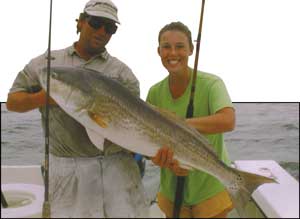
Before fishing became a blood sport, anglers hadn’t been on a mission to develop the best lures and tackle to outwit targeted species. With new tackle being developed daily, tackle manufacturers always are looking for an edge to outwit gamefish.
Obviously, fishing tackle meets different needs. For example, fishing line needs to be strong and pliable enough to cast a lure and wind up easily on a spool. But if it’s too visible, fish may shy away from a lure attached to a particular type of line.
Artificial lures also should mimic natural organisms enough for a target species to strike (except in the case of buzzbaits for bass; nobody knows exactly why a largemouth bass will smack a buzzbait).
Live baits need to remain and appear in a natural state and, for the most part, unobstructed in order for them to become supper for a passing fish.
The perfectly-matched combination of strong, effective, visible and invisible line will make or break anglers’ success.
I love to catch king mackerel, which boast a mouthfull of razor-sharp teeth. However, if you don’t use a strong wire leader near the hooks, you’ll never keep a king on the end of the line longer than a few minutes or seconds. If he ever gets a monofilament leader in his mouth, it’s bye-bye Mr. King. And if you happen to be fishing in a tournament (nobody competing would make such a mistake), a foolish mono leader could cost you and your teammates thousands of dollars.
Sure, anglers could get more king mackerel strikes if they used 4-pound-test line with No. 4 wire hooks, but a strike isn’t worth much without getting the fish back to the boat.
Is this a Catch-22 problem with no discernible solution? So how does an angler use heavy and light tackle at the same time?
With live-bait trolling, king mackerel anglers have learned to use thin wire leaders for abrasion resistance to prevent cutoffs from a fish’s sharp teeth and relatively thin monofilament above the leaders (moderately thin anyway) that won’t spook the fish. Then, once a king is hooked, anglers rely upon reel drags and flexible rods to get the fish to the boat.
The accepted theory that “the bigger the bait, the bigger the fish” is true in most cases, especially with live bait. But what if an angler is dragging a large live bait, but there aren’t any fish in the area big enough to eat a bait that large? Pretty simple. No fish strikes or strikes without hookups.
Fish are more likely to strike a smaller bait than a larger bait, in most cases, which means, ergo smaller is usually better when it comes versatile fishing.
Want an example? How about the tarpon that frequent S.C. waters? They’re most adults and range from 50 to 150 pounds.
But tarpon more likely to eat a small 10-inch menhaden, than 15-inch mullet. Not that a 100-pound tarpon couldn’t eat a 24-inch spot-tail, but they’re more likely to eat smaller meals.
Smaller live baits are quicker and easier meals for predators.
Using smaller baits will usually produce more strikes and in turn, more fish in the box.
How about artificial lures, big versus small? Which is more effective?
Large artificial lures probably work great in Canada for huge muskies and for peacock bass in South America, but large artificial lures apparently don’t look good or have the enticing action of smaller lures.
Most Southern gamefish feed on what is available, which primarily consists of smaller fish and crustaceans. Remember that when using soft-plastics or hard baits; smaller-size lures usually work better.
Smaller baits and lures will improve catches, but probably more important than lure size is the size of other stuff — including line, leader and other terminal tackle. Fishing conditions and targeted species’ characteristics will determine what kind of line and level of terminal tackle anglers need.
The new braided lines, fluorocarbon and strong monofilaments should be used in combination. I’ve resorted to using the new spectra fiber made by Power Pro with many of my reels. But I will attach a 8- to 10-foot terminal leader made of fluorocarbon, depending upon water clarity.
Then one should have the best of both worlds — the stealth of fluorocarbon to initiate strikes and the strength of braid for cranking the fish to the boat.
In order to become a better angler, it’s best to get a fish to strike with ease and get it into the boat. Angling technique is always going to be important and will determine how successful one becomes. But without the correct combination of line, leaders, terminal tackle and lure sizes, maximizing one’s effort won’t happen.
So use the thinnest leaders possible and smallest hooks, terminal tackle and lures to improve chances for success.
Less often really is more when it comes to fishing in freshwater or marine environments.




Be the first to comment